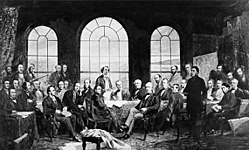- Delegates from the Legislatures of Canada, gathering on the steps of Prince Edward Island's Government House for the Charlottetown Conference – Photo by George P. Roberts on September 11, 1864.
- Delegates of the Legislatures of Canada gathering at the Quebec Conference – Photo by Jules I. Livernois on October 27, 1864.
- An 1885 photo of Robert Harris' painting, completed the previous year and titled, Conference at Quebec in 1864, to settle the basics of a union of the British North American Provinces, also known as The Fathers of Confederation. The original painting was destroyed in the 1916 Parliament buildings Centre Block fire. The scene is an amalgamation of the Charlottetown and Quebec City conference sites and attendees.
| This article is part of a series on |
| Canadian Confederation |
|---|
 |
| Conferences |
| People |
| Related |
| |
The Fathers of Confederation [a] are the 36 people who attended at least one of the Charlottetown Conference of 1864 (23 attendees), the Quebec Conference of 1864 (33 attendees), and the London Conference of 1866 (16 attendees), preceding Canadian Confederation. Only twelve people attended all three conferences.






































